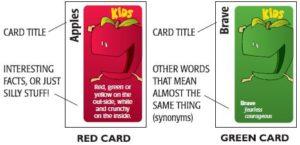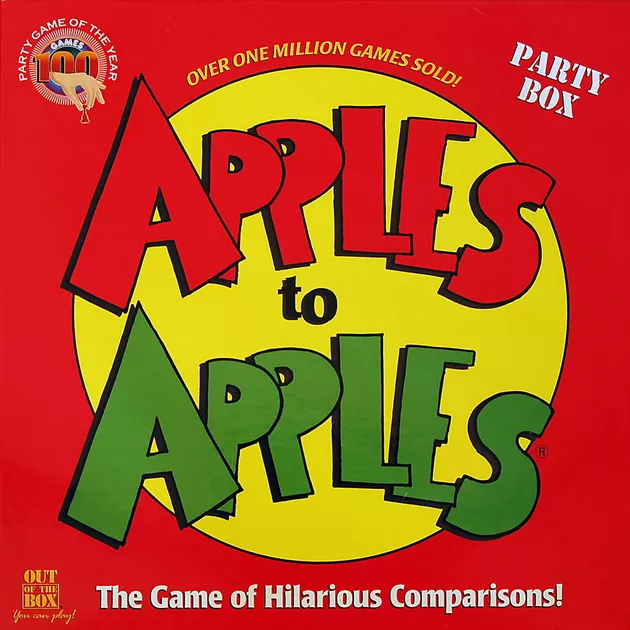Game: Apples to Apples
Creator: Mark Osterhaus, Published by Mattel
Platform: Analog
The target audience of the game is for people 12 years of age and older, and is meant to be played in group sizes of 4-8. I have played Apples to Apples in the past with much larger groups at things like summer camps, where up to 15-17 people play at once. I don’t think it’s as interesting when the number of players dips below the minimum, however. The players themselves don’t have to be particularly close, and the game itself doesn’t require that players get too vulnerable. The focus is more on the cards themselves, rather than the actual players. However, one thing to note is that because Apples to Apples is a judging game, it helps that players are in a similar age range because consequently, players tend to have a closer sense of humor, and therefore, enjoy the game more thoroughly.
The game starts with everyone in the group being dealt 7 red cards. Each red card has a noun on them, and a short, quirky description of the noun. One person starts as the judge, and places a green card in the middle. All green cards are adjectives, and there are two synonyms written on the bottom of the card to help players. Then, everyone except for the judge places a card down that they believe best matches the adjective. After everyone has placed a card, the judge picks up the cards and chooses the one that they believe is most fitting. The owner of that card gets to keep the green card, and becomes the judge for the next round. Each of the players pick up a new red card. The game continues in this cycle until someone wins 5 green cards (or whatever the group decides to be the threshold).

The game is most centered on fun through fellowship. While at the foundational level the players’ job is to find a card that best matches the given adjective, there is a huge component of pleasing the rest of the crowd as well. Often, judges will read each of the responses out loud, prompting reactions from the rest of the players, whether it be laughs or disapproval. Sometimes, the card that wins will actually be the most ironic. In any way, the judging is not limited by the given rules, and players fight for the approval of other players, which can influence the final verdict of the judge.
This game works on several levels. For one, players are given the challenge of calculating their best fit card to the adjective. On a more logistical level, the game can be as fast or slow-paced as the group wants it to go. It can also last for long because it is easier to drop and join back in the middle, making it more inviting. On a social level, it is a great way to get together a large group, regardless of their level of their intimacy. It can even bring strangers closer together, like through the shared laugh at a card.
There are still many improvements that can be made. Players who have played Apples to Apples on multiple occasions tend to know what cards are in the deck, making the novelty of getting a weird noun not as exciting in later plays. On the flip side, many players don’t always know what the noun means, and won’t understand how to use certain cards in their hand. Although there are descriptions at the bottom of the card, sometimes the reason a card works is because everyone in the group has a mutual understanding and social context of the word. Some smaller issues that could arise is if two people continuously choose each others’ card back and forth, causing the rest of the players to lose interest.
A similar game to Apples to Apples is Cards Against Humanity. CAH uses the same game mechanics, but differs in a few ways. First, the “red” cards are phrases that answer the “green” cards, which in this case are not adjectives, but fill-in-the-blank sentences. Additionally, there is a wider variety of responses available since some prompt cards have multiple blanks, and there are cards where you can fill in the the blank with your own word. CAH is also aimed towards more older audiences, given that the content in cards is more mature. In contrast, Apples to Apples is for younger audiences. Because of this, it is, as mentioned before, difficult in some scenarios for players to understand certain cards in Apples to Apples, since the words can often be proper nouns that younger players don’t know. I think choosing CAH or Apples to Apples is a matter of context. Apples to Apples is more stranger and kid-friendly, while CAH is better in closer friend groups.



